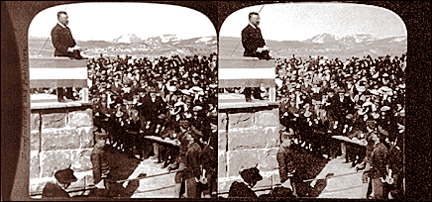

News | Experts | Today@Sam | Dates | Stats | Sam the Man | History | Archives

President Theodore Roosevelt delivers a speech at the entrance to Yellowstone National Park in this 1903 stereograph distributed by the American Stereoscopic Company.
Stereograph Exhibit Documents Early History of Yellowstone National Park
Over 100 historic stereographic images featuring scenes from Yellowstone National Park are on exhibit at the Sam Houston Memorial Museum.
The stereographs, also called stereo views, trace the evolution of the extraordinary Yellowstone wilderness, from a pristine landscape once shrouded in myth and mystery, to its turn-of-the-century emergence as a popular tourist destination.
 Additionally, the exhibit showcases an antiquated photographic format, stereophotography, a popular medium of the late 19th and early 20th centuries. Stereographs feature dual images taken from slightly different perspectives to produce a three-dimensional effect when viewed through an optical device called a stereoscope.
Additionally, the exhibit showcases an antiquated photographic format, stereophotography, a popular medium of the late 19th and early 20th centuries. Stereographs feature dual images taken from slightly different perspectives to produce a three-dimensional effect when viewed through an optical device called a stereoscope.
The Yellowstone stereo views are on loan from the private collection of Robert C. Berry, proprietor of the Overhead Door Company of Huntsville. In the 12 years Berry has been collecting stereographs of the park, he has amassed approximately 2000 images, many of which are extremely rare. His collection was recently showcased at a historical symposium held at Yellowstone Park.
The memorial museum exhibit features a representative selection of Berry's stereoscopic treasury, and includes some of the earliest known stereo views of the Yellowstone region. Among them are images captured by Joshua Crissman, guest photographer to the 1871 Barlow/Heap and the 1872 Hayden expeditions into the area.
Yellowstone, the world's first national park, was established by Congress in 1872.
"Stereo photography was one of the earliest means of image making in the park," Berry explained. "These images are important because they have given us some of the most authentic historical records of the park's ecological, geological and structural evolution."
In their day, Yellowstone stereo views also played an important role in fueling America's growing fascination with the West. They were among the first widely distributed photos of the astonishing landscapes and geothermal wonders first reported by legendary mountain man Jim Bridger. Viewing these mass-produced stereographs of the wild and unusual Yellowstone region, Berry said, was a popular diversion in the drawing rooms of Chicago, New York and St. Paul. They were also widely used by educators to illuminate lessons on the rapidly diminishing American frontier.
The technology of stereo photography is almost as old as photography itself. The first practical development and production of stereographs was in 1850, about 13 years after Louis Daguerre's and Joseph Niepce's first silver plate photographs. A widely attended 1851 stereo view exhibit at the Great Exhibition Hall in London stimulated public demand for the prints.
Commercial production of stereo views accelerated with the development of the more practical collodion wet plate photographic process. That process was almost exclusively used until 1881.
Most of the stereographs included in the memorial museum exhibit were manufactured with the collodion process.
In the U.S., after the Civil War, railroads hastened America's westward expansion, but it was the images of the West in all its grandeur, that sparked the dreams of those who ventured forth. The vast, unexploited West, with all its promise, became an integral part of the national identity.
Images of Yellowstone, home to some of the nation's most unusual natural wonders, were in high demand. The early stereographs of the region, dating back to 1871, played a significant role in the park's incredible popularity.
Berry's Yellowstone stereograph collection also documents the rise of another American phenomenon -- tourism. In the early 1880s, a wealthier class of citizenry looked to travel as a leisurely pursuit. For them, the Northern Pacific Railroad provided a direct link to "Wonderland," a popular name for Yellowstone in the park's early days. Stereo views of Yellowstone, Berry said, were often sold on the trains and quite frequently the tourists themselves were featured in many of the images.
The Yellowstone stereophotography exhibit will remain on display at the Sam Houston Memorial Museum through June. It can be viewed in the museum's basement gallery.
The Sam Houston Memorial Museum complex can be accessed from 19th Street, between Sam Houston Avenue and Avenue N in Huntsville, Texas. The museum is open from 9 a.m. until 4:30 p.m. Tuesday through Sunday. Tours are given Saturdays and Sundays at 1 p.m. and by arrangement to large groups. For more information on museum programs, exhibits or special events, call the main office at (409)-294-1832. You can also visit the Sam Houston Memorial Museum web site.
For more information on the world's first national park, visit Jim Macdonald's Yellowstone History Guide or the National Park Service's Yellowstone web site
-END-
Media Contact: Phillip Rollfing
Comments: Today@Sam.edu
March 5, 1998
This page maintained by SHSU's Office of Public Relations
Director: Frank Krystyniak
Media Relations Specialist:Phillip Rollfing
Located in the SHSU University Advancement Building
Telephone: (409) 294-1836; Fax: (409) 294-1834
